My name's Ayman Husain and in this article, I'll share with you my thoughts on how designing or redesigning the digital transformation journey with our customers at the heart of it will truly enable a transformative and scalable Software as a Service solution.
This will lead your business success and growth and help you manage through challenging times.
Introduction
I live in the United States of America, and I'm presently located in the great city of Houston. I work for Microsoft Corporation and I've been here since 2017. I come from a background in management and strategy consulting.
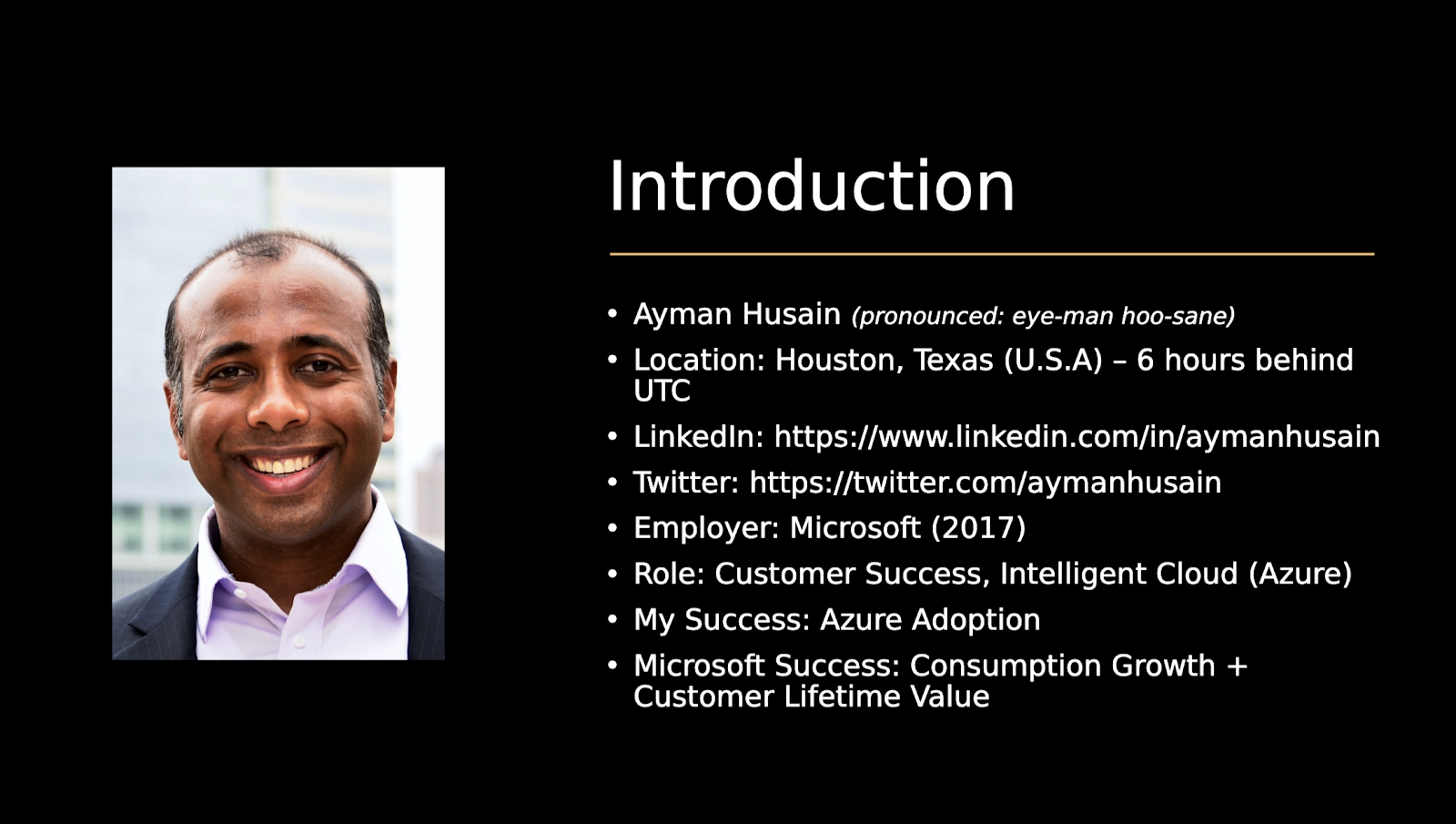
The role I have today at Microsoft is that of customer success. I'm a Director for the Intelligent Cloud business, also known as Azure, one of Microsoft's cloud offerings alongside Microsoft 365 and Dynamics 365.
What do I consider success for my role? My success is Azure use and adoption by all my customers and clients. What is Microsoft's success? Well, simply put, it is the consumption growth of Azure and increased customer lifetime value.
I transform my customers to attain success with their goals and objectives. Every customer has a customer, I make their goals mine, and work to transform their business using Microsoft cloud platforms and solutions. Regardless of what industry or segment, I want my customers to achieve more, do more, and succeed more.
Some context
I want to look at digital transformation and SaaS - Software as a Service. I've included some definitions of what I believe digital transformation to be and what Software as a Service is to me.
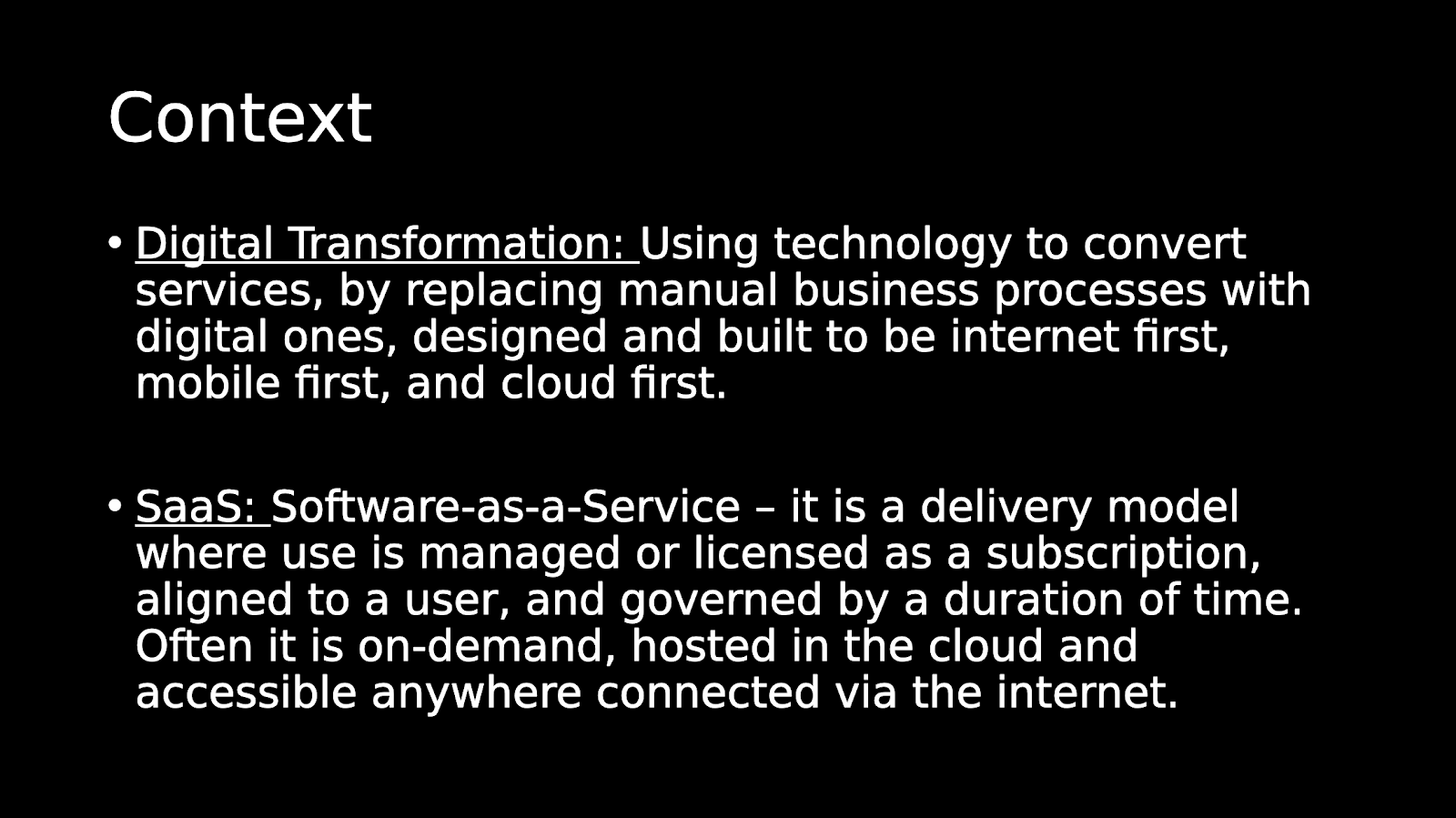
Digital transformation
Digital transformation is a technology to convert services by replacing manual business processes with digital ones designed and built to be internet-first, mobile-first, and cloud-first.
Keep that in the mind throughout the article.
Software as a Service
It's a delivery model where use is managed or licensed as a subscription, aligned to a user, and governed by the duration of time. Often it is on-demand and in the cloud accessible anywhere via the internet.
Put that also in the context of my article.
Examples
Now some examples of what Software as a Service or digital transformation is in this context.
Digital transformation: travel & hospitality
Look at the travel and hospitality industry. If you have booked airline tickets or hotel rooms, you know how simple and easy it is today to do so on the internet. But think back 20 years, 30 years, even 40 years.
Think back to when you needed a travel agent, you needed to go to a physical location, a travel agency itself. The travel agent, perhaps with a computer on their desk or perhaps through the phone would reach out to the airlines, the hotels, and various other places to book a room, a flight, or car.
Examples are boundless and endless. Let's look at some examples of these transformations that have happened in the industry today. British Airways, Emirates, American Airlines, Marriott - all these companies have:
- The entirety of their inventory,
- Maintenance of aircraft and vehicles,
- Availability,
- The destination,
- The routes,
- Configuration,
- Staffing,
- Housekeeping,
- Foodservice,
- Cancellations,
- The ability to take money,
- Remit,
- Payment.
All of that has been transformed using digital technology.
There are transformation levels, so to speak and we are still working to achieve a fully transformed industry, especially in hospitality and travel. But it has come a long way so when you think of digital transformation, think of that industry and how they have morphed in a span of 10-20-30 years to become all internet-based and technology-based.
To the point where travel agents no longer exist in the way they used to as a brick-and-mortar location. They're not all digital, some of them are automated, some of them don't even exist with a human behind them. That's a transformation example that I like to refer to quite a bit.
Saas: media & productivity
Now let's look at Software as a Service by looking at the media and productivity industry today. Streaming music, email, photography storage, think of all the examples I have listed below, Netflix, Spotify, Disney+, Apple TV, iCloud, Amazon Prime, Outlook email, Gmail.
All of these industries have taken their services or products and services and extended it through Software as a Service. They have to plan for:
- Customer acquisition,
- Subscription packages,
- Payment,
- Enrollment,
- Cancellation,
- Service availability,
- The content.
If you're a movie or streaming show provider:
- The uploads,
- The ability to upload and download fast on multiple devices.
Think of that industry itself, Software as a Service has revolutionized how they provide the services.
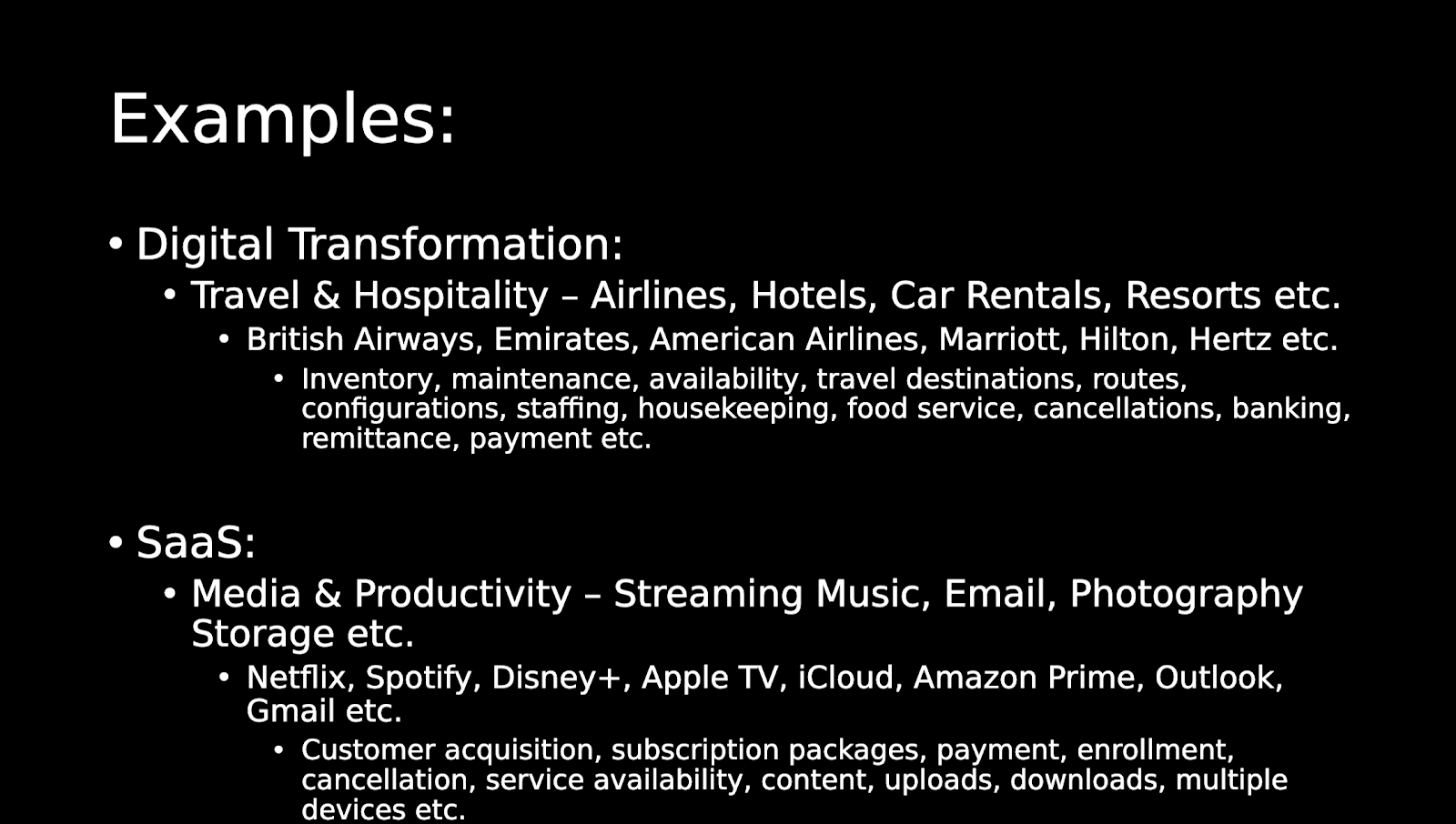
Let's now take those examples of digital transformation and Software as a Service and put them into context.
What are you?
The question to you is, where do you fit in this context? What are you doing in this context?
- Are you a vendor?
- Are you providing Software as a Service?
- Are you a service provider?
- Are you a provider of the platforms?
- Are you the underpinning of the Software as a Service, the databases, the network, that topology, the geography locations?
All of this decides how you can customer centrically focus your digital transformation. What is your core competency in this relationship?
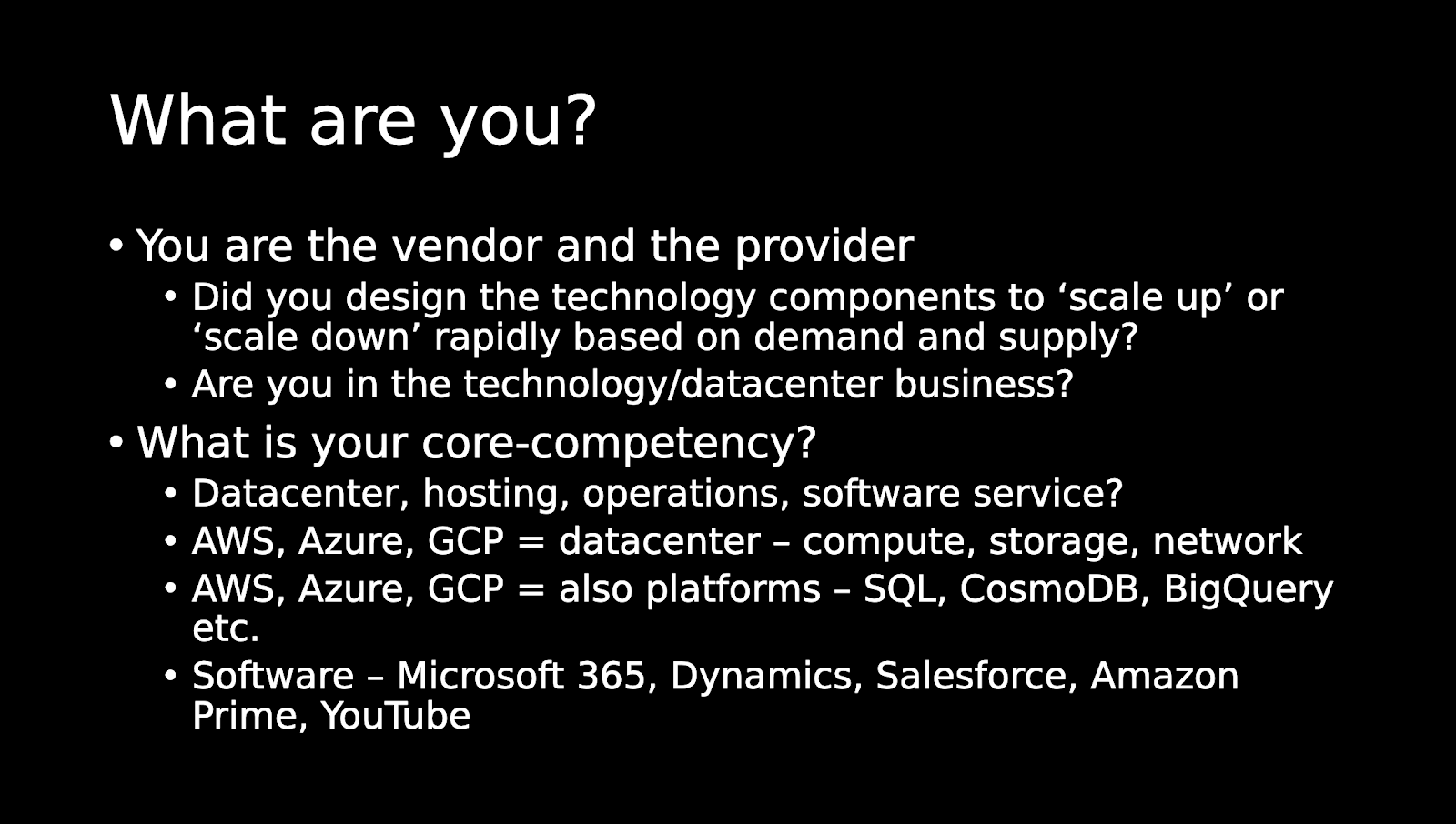
Examples
I'll use some examples of companies that I'm familiar with, and so you may be as well.
- AWS is the organization that Amazon owns, that has the public cloud service.
- Azure, Microsoft's public cloud service.
- Google Cloud Platform, Google's service providing.
These are examples of organizations that actually have brick and mortar, they have servers, they have storage, they have network locations, their success is capacity at scale, and get ahead of demand.
They are data center providers, they are more than that today. But think of the core competency of that group of people that have to make sure capacity is always there, networks are connected, storage is available.
Their Customer Success is very different because it is based on a quantity of inventory that has to be available at all times.
Now, think of the platforms that may run in this, let's use an example of a sequel environment, a database, let's use CosmoDB as an example, a common NO SEQUEL platform available in many different organizations.
BigQuery for GCP, these are platforms, they also have a criterion of success, their platform has to be available all the time in different weights and constraints that are designed for the service availability.
It does not have anything to do with the storage and the network and the topology that it rides on. Because that group of people - infrastructure as a service providers - has criteria for success behind that. But the platform also has a criterion of success behind it.
A true SaaS mindset
Now let's move into a true SaaS mindset. Let's look at examples like Microsoft 365, Salesforce, Amazon Prime, YouTube, Netflix, these are examples of SaaS, Software as a Service, they have a different set of criteria as well.
Each of the variations of digital transformation required them to change the process via which they redefined or changed to be a success for.
- Where are you in this environment?
- Are you providing the service to scale up or scale down?
- Are you rapid?
- Are you the technology provider data center business?
- What is the competence that you bring in?
This will decide how you will have to redefine your customer acquisition and the success that goes with it leveraging Software as a Service. This is the nexus of thought for how we are succeeding in this industry, and understanding that journey of digital transformation.
An example here I'll use Microsoft 365 as a core competency here for myself, I know that business quite well. If you want to have an email account, if you have the productivity suite of office, Word, and Excel, all that goes with it, it's running on a platform and that platform is running on hardware and servers.
It so happens Microsoft owns all of those three layers that are underneath it. The data center provider, the physical geography location, network, plumbing and all that goes with it is a customer success that data center group has a focus on.
If you look at the platforms, the databases, Active Directory, the security components, there's another group of people that focus on that as well.
Finally, the Software as a Service itself, the email accounts, the ability for you to use the Word app, the ability to sign in and see if you have the license that goes with it. That success also is based on a group of people that are taking that journey map of digital transformation.
All that put together will give you the success criteria of growing your business or not, our succeeding in challenging times like we are in today.
Recap - delivery models
Level set this model, let's have a look at the classic example of what IaaS, PaaS, and SaaS look like.
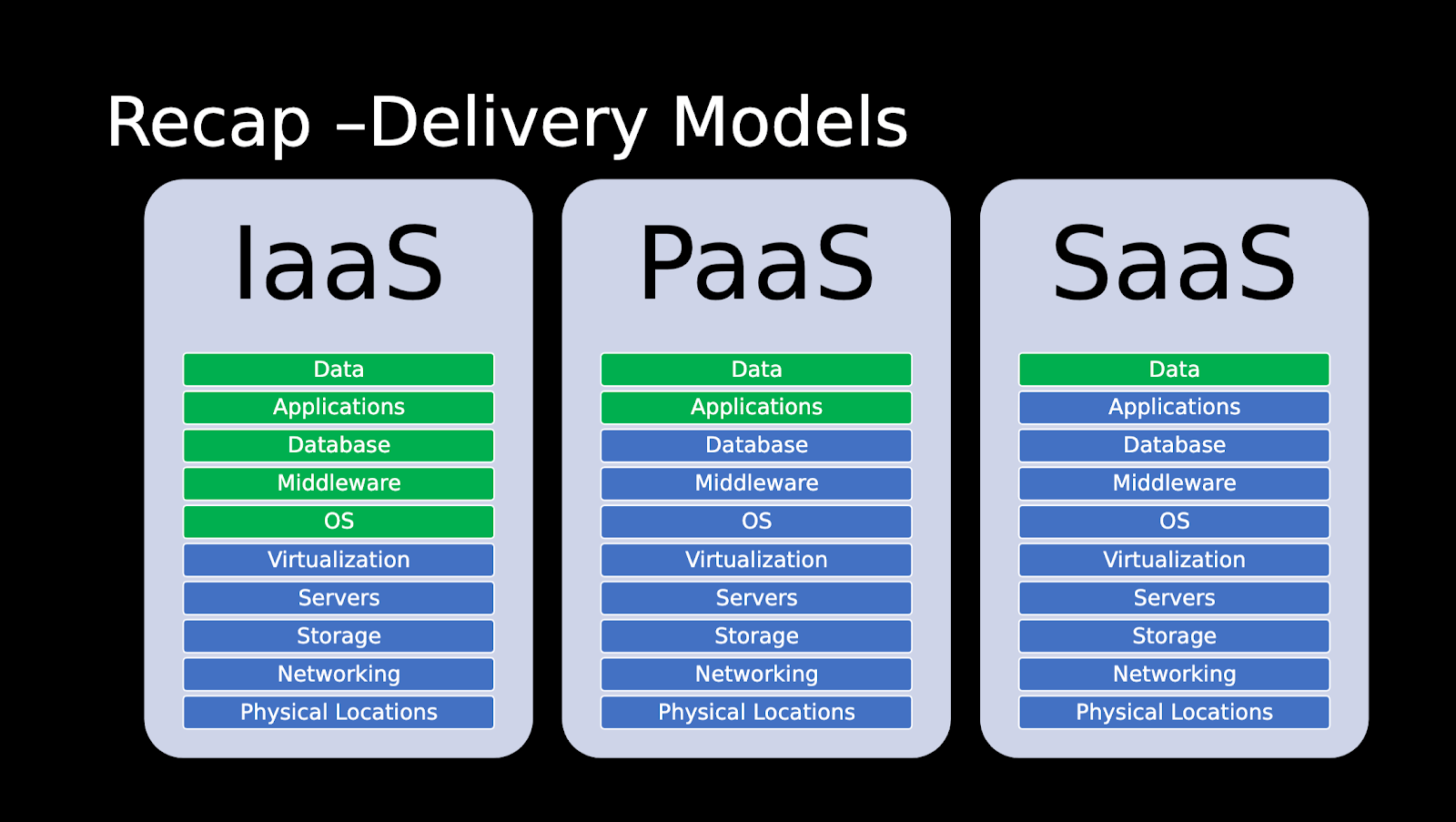
You've seen this graphic, this is one I've put together for this article, it comes in various ways. I've color-coded the green and the blues, the greens are the places where the focus of the owner of that platform delivery model would be.
SaaS
If you're a Software as a Service provider, you're looking at enabling the consumer to have access to the data, the customer or the consumer in this place cares for nothing but the data.
They want to make sure their pictures are uploaded, their YouTube video content is uploaded and available to them. They're not looking at the applications that go underneath that, they're not looking at the database that goes underneath, they're not looking at the middleware, and so on and so forth.
So if you are a Software as a Service provider, if you have created an amazing application that you want to scale out to your customers, think of the fact that customer needs to have an application to be available at any different place, any different time, on any different device.
All they want is their data, the data is the glue that brings them to you. If you can design an application that has the scalability capability to do truly growth-centric capability, then you now have a winning model.
Let's use YouTube as an example here as well. If you're using YouTube, and you're a consumer of it, you want to load your video, and you want people to look at the video, and it'd be available in a short amount of time.
Think of the app itself, let's now imagine you're the engineer or the product group that makes the YouTube app. Think of all the different ways that the app is available today to you. You have any mobile device, you may even actually have it on a Smart TV, you have it on your desktop to the web browser, you may have it on an iPad, or a tablet device with Android, the app.
The engineering group of people that are in writing that app has to now think of all the different ways that app has to be available because it's a Software as a Service. They cannot contain it by having a limitation on scale, they have to make it broadly available all over the world so that anybody who uses the app now can upload videos and consume them in the same way.
Think of the business model that YouTube has behind it. They allow advertising, they look for clicks, that brings viewers to those videos. Now that's a service the YouTube product, the product group that is marketing it is selling it.
So if you think of the revenue they will get from having this app available to the consumer, you have to make sure the scale behind it is available, and the information that goes with it is available for the insights they need.
If there's a certain uptake of people that started using YouTube and loading large content, large video files, then they need to have the scalability that goes with it. As an engineer, as a developer, you now need to use all the latest and greatest technologies that go in Software as a Service design model from all these providers you just looked at and have an example of.
You start using things like containers, and you start using scalable databases, geography wise available anywhere and have the ability for you to scale. When you think of Software as a Service, and the customer success that goes with it, you have to understand where the complexity is, so you can scale up and scale down.
PaaS
Now let's look at a Platform as a Service company using the example of GoDaddy. If you're not familiar, GoDaddy is a domain provider but they also have all the services to go with it.
One of the things they allow people to do is create websites they will host and then make them available for you. The person that designs the website is the actual consumer.
So they're really looking at it from the context of the platform and the data that goes with it. But GoDaddy as the web portal provider is looking to make sure the servers are available, the network is available behind it.
Their success is a little different, they're not going to fixate on that being available everywhere, because they may have a service level agreement, they may say that we will make sure that it's available to you at a certain time in the context of how it's going to be delivered.
So there are SLAs that go with it so now you're creating a success criteria model for the digital transformation on the journey. If somebody needs a website right away, they'll have to have an onboarding capability and a practice of getting that website or the content readily available. Secure the payment, make sure that the SLAs are met and give that customer or consumer the product value that they need.
Think of the scale that needs to go with it. Again, as a Platform as a Service or Software as a Service designer in a product engineering group, you will have different things you have to think of and do for the design of it.
The criteria are always different and that journey will also differ with that criteria. Now if you're a hosting company, and you're just doing servers and data centers, you might have different criteria for it. You may have geographical locations, you may need to have the ability for you to think of that customer success criterion that goes with it.
But since we're talking about the future of SaaS, think of the fact that when you design that app, you have to make the app available for your customer, your consumer, the end-user in a way that is not beholden by geography, location, or capacity. That design model, that design thinking that goes with it will be the crux of success.
Why does it matter?
Now let's look at why it matters to you. Think of an app like Zoom, or Microsoft Teams, Amazon Prime, think of the fact that now that we are in this COVID situation, people are using technology over the network quite rapidly and quite excitedly.
Scale is paramount
When we have to provide that, we have to understand that scale is something that has to be inherent to the design, we can not have a bottleneck. The bottleneck will stagger down in a cascading fashion. Think of the scale as paramount.
Speed is critical
Speed is critical so decision-making using those investments that you're going to put towards technology, people, and resources have to reflect the success that goes with it for the revenue that you're going to generate or the investments that you're going to make.
Visibility
Now the visibility, the what, where, when, and how really determines how you're going to be successful.
The lowest common denominator
One of the challenges I've found in my job as a strategy consultant, management consultant, and also working for Microsoft, is usually an air gap, a lowest common denominator, I call it the air gap, the lowest common denominator makes it or breaks it for the success that you need to have.
That common denominator is how you can succeed and transform your journey for a customer and the apps that you want to provide in that space.
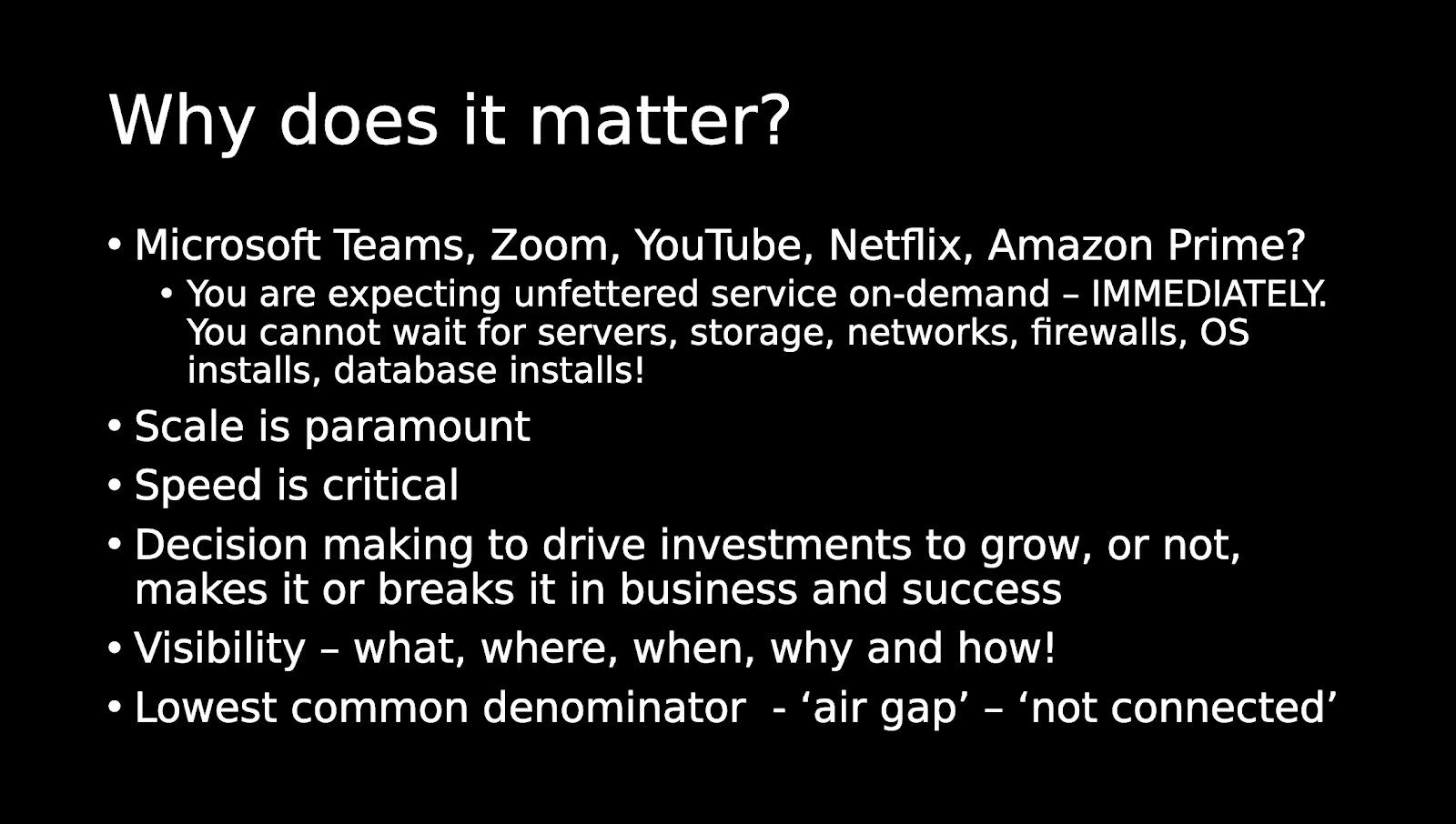
Redesign the process
We have to redesign it for the lowest common denominator.
Customer/client/user - first
If you are a customer or consumer-oriented organization, you need to know your client. You need to know:
- Are they a shopper, a viewer, an uploader?
- Are they going to book travel?
- Are they air travel themselves?
Acquisition - where, how, when?
- How are they coming?
- Where are they coming from?
- Are they going to use a mobile device?
- Are they going to use a smartphone?
- A web browser?
- Telephone?
- Do you need transcription?
All those different things are the acquisition model of the customer.
Know your customer/buyer
You have to know what they are going to buy and what they're going to look for so perhaps use a little bit of artificial intelligence to get a basis of how that common denominator is going to impact your design and the process that goes with it.
Know your lowest common denominator
If there's an air gap in any of this process, for example, if you have a credit card that needs to process a payment, and you don't have a system that's integrated, there's an air gap.
Maybe there is a decline in that feature and because of the decline, the subscription is not enabled. You have to understand the air gap of the system and the journey of the customer that will come through in the system. That is what I call the lowest common denominator.
Understanding the choke points, understanding the database updates that may take time if there's a large database or data warehouse it may take time, if there are external parties, if you're sending it to a credit processor, if you're waiting for shipping logistics information from a shipper, you have so many different things, there may even be human intervention, maybe there's an inventory management system that requires somebody to go count things on a shelf, that alone can also create an air gap.
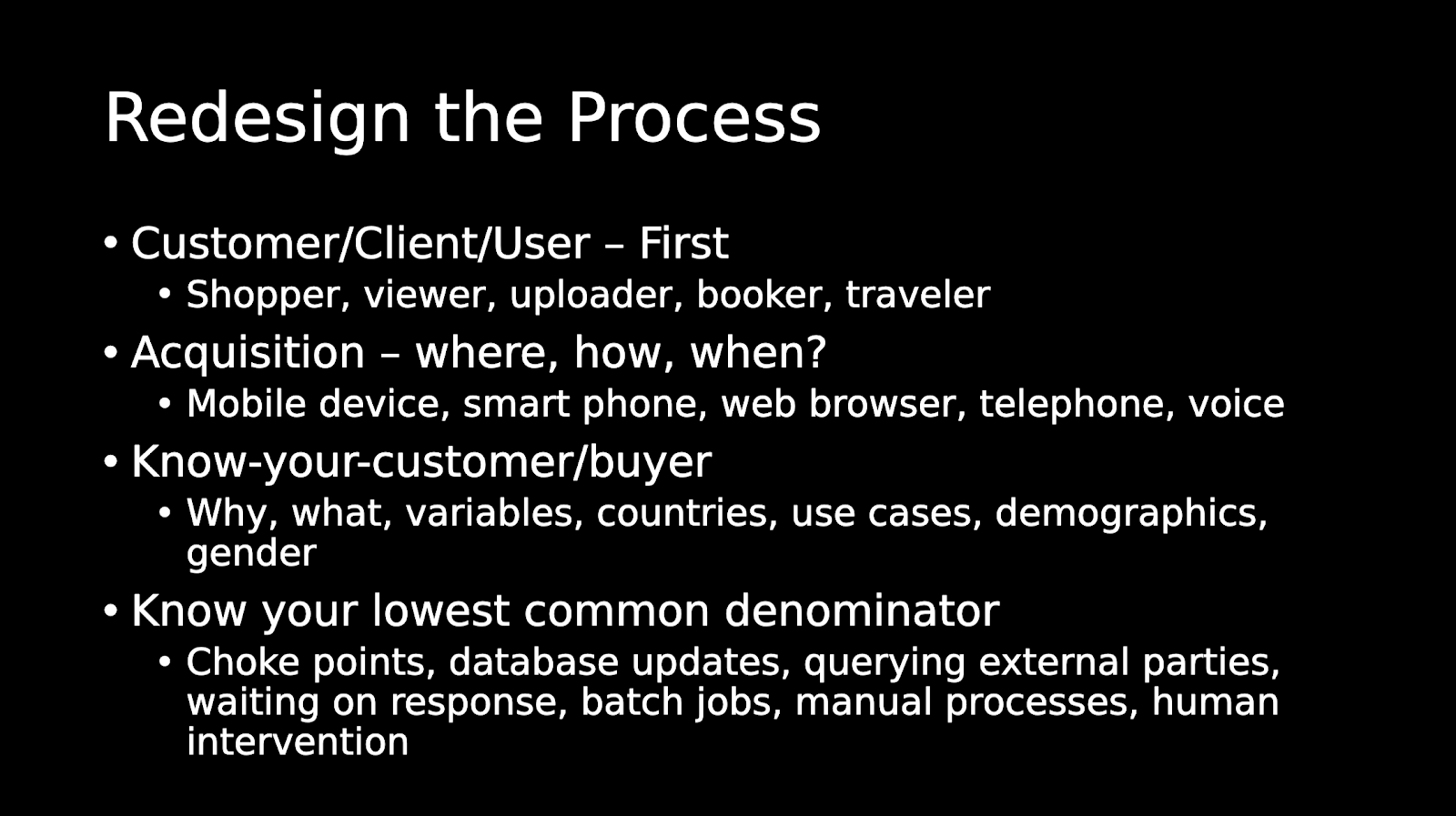
That lowest common denominator for your success will be impacted in that space. Take all that back and take all that into the context of how you're going to redefine your customer success and customer journey - finding that chokepoint, finding that place where your success for a Software as a Service app is going to stop and prevent itself from being scalable, highly available on any device through the internet at any given time.
Examples: COVID
Zoom is a good example of how success was measured during the COVID pandemic era. Microsoft Teams, video conferencing, the ability for you to have a massive number of people join anywhere in any place.
In the United States, schooling went remote so a lot of the kids in schools had to do this and get the curriculum and their studies and education delivered through remote devices.
They have diverse 4G networks that are slow networks, the bandwidth is constrained, that could be the lowest common denominator.
For example, if you're traveling overseas as an Instagrammer and you take a lot of pictures, you need to know that a slow network in a developing country may be the choke point for you.
Recap
When you think of Software as a Service you want to make the customer journey successful and the transformation that goes with it.
I have learned from my time at Microsoft as well as a consultant that you always want to focus on the lowest common denominator, the choke point, the air gaps, so you can create a format, a process via which you can succeed and give the success to your customer, the end-user.
Data is likely what they're going to use in your app and if that data is available to you and them at the same time now you have the insights to query the processes of artificial intelligence containers, the ability to use scalable data sets, and multiple zones and gateways and wide area network firewalls that give you the ability for you to scale that design without having those chokepoints.



